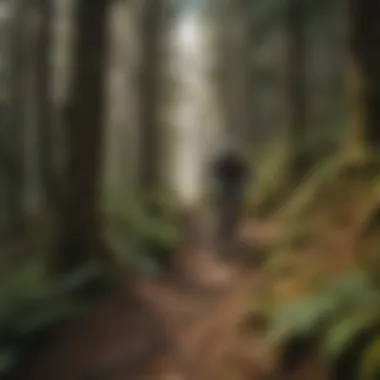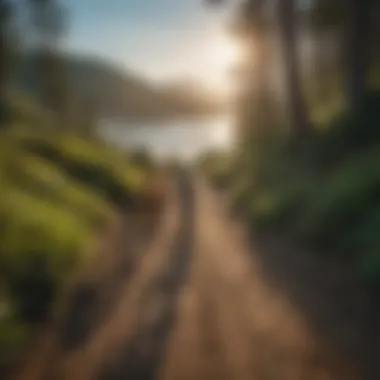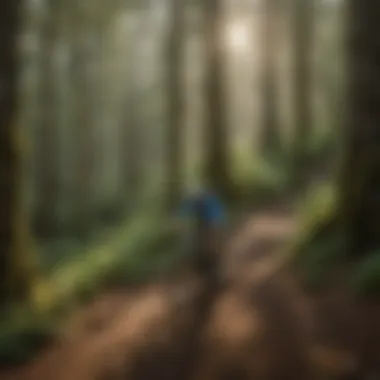Mountain Biking Adventures on the Oregon Coast


Intro
When one thinks of the Oregon Coast, waves crashing against rocky shores and dense forests might come to mind. Yet, there’s another side to this mesmerizing landscape that beckons adventurers to explore: the exciting world of mountain biking. From rugged coastal paths to serene forest trails, the Oregon Coast offers a remarkable array of biking opportunities that cater to every skill level. This guide aims to not just highlight these trails but also emphasize the ecological significance they hold and the sheer joy that comes with each pedal.
Evergreen Trees Species
One cannot talk about the Oregon Coast without acknowledging the impressive evergreen trees that define its lush forests. These giants not only provide a breathtaking backdrop for mountain biking, but they also contribute significantly to the region's biodiversity and ecosystem.
Types of Evergreen Trees
The Oregon Coast boasts a variety of evergreen tree species, each playing a crucial role in its ecological tapestry. Key species include:
- Douglas Fir: Known for its towering height and strong wood, this tree thrives in the coastal area's moist conditions.
- Western Hemlock: This shade-tolerant tree often associates with damp, wooded environments, offering a rich habitat for wildlife.
- Sitka Spruce: A true coastal native, Sitka spruce is renowned for its tall, straight trunks and ability to withstand harsh coastal winds.
These trees not only add beauty but also offer unique biking experiences as trails weave through their canopies.
Ecological Significance
The ecological importance of these evergreen trees goes beyond aesthetics. They contribute to:
- Carbon Sequestration: Evergreen forests effectively absorb carbon dioxide, playing a vital role in mitigating climate change.
- Watershed Protection: Their roots help stabilize soil and manage water flow, reducing erosion and safeguarding waterways.
- Wildlife Habitat: These trees provide essential habitats for various species, which can enhance the experience of mountain bikers by allowing them to witness diverse wildlife.
"Healthy forests offer a wealth of benefits, from clean air to thriving ecosystems."
Conservation Practices
As the world faces the pressure of climate change and deforestation, it becomes imperative to adopt conservation practices to protect our evergreen trees. Here are a few noteworthy strategies:
- Reforestation Initiatives: Restoring lost forests can help replenish the majestic trees that define the Oregon Coast.
- Sustainable Logging Practices: Encouraging responsible timber harvesting ensures that forests can regenerate and remain healthy for future generations.
- Community Engagement: Local organizations often rely on community support to foster awareness and encourage preservation efforts.
Forest Management Techniques
It’s vital to explore effective management techniques that can support both the forest's health and the recreational opportunities available to mountain bikers.
Wildlife Habitat Preservation
Maintaining biodiversity goes hand-in-hand with preserving wildlife habitats. Strategies like:
- Creating Protected Areas: Establishing reserves ensures that sensitive ecosystems remain undisturbed.
- Intelligent Trail Design: Designing trails to minimize disruption to wildlife routes maintains ecological balance without losing recreational space.
Sustainable Logging Practices
There’s a growing movement towards sustainable logging operations designed to manage tree harvesting responsibly. This involves:
- Selective Logging: Only certain trees are harvested while preserving overall forest health.
- Improved Best Practices: Using machinery that reduces damage to surrounding trees can keep forests resilient.
Fire Prevention Measures
Living with fire risk is part of forest management. Some approaches include:
- Controlled Burns: These can help clear out underbrush that fuels larger wildfires.
- Monitoring Programs: Early detection systems are critical in managing fire threats effectively.
Ecosystem Restoration Initiatives
Biking along the Oregon Coast gives riders a chance to reconnect with nature and learn about ongoing restoration projects aimed at rejuvenating degraded lands. Initiatives such as:
- Wetland Restoration: These projects can improve biodiversity and overall ecosystem health, promoting greater enjoyment for outdoor enthusiasts.
- Invasive Species Control: Removing non-native species ensures local flora thrives, enhancing the beauty of bike trails.
End
As you embark on your journey through the Oregon Coast's mountain biking trails, remember the interconnectedness of the landscapes that surround you. Those towering evergreens and vibrant ecosystems do more than just make for a pretty picture; they are integral to the health of our planet. This guide hopes to illuminate not just the trails, but the broader significance of the natural world that every rider encounters.
Prologue to Mountain Biking on the Oregon Coast
Mountain biking along the Oregon Coast presents an enriching outdoor experience, blending the thrill of biking with the breathtaking scenery of the Pacific Northwest. This region is known for its rugged landscapes, lush forests, and coastal vistas that attract both beginners and seasoned riders. Riders will find an array of trails that cater to varying skill levels, making the sport accessible to anyone eager to explore the great outdoors.
Historical Context
The adventure of mountain biking in Oregon Coast isn’t merely a modern pursuit; it's rooted deeply in the area's history. Back in the 1970s, as bicycles began evolving with better designs for rugged terrain, many enthusiastic riders took to the forest trails and coastal routes. While the advent of mountain biking brought a wave of adrenaline and ecological awareness, native populations had long enjoyed the region's natural landscapes. They left their mark through trails that became the foundation for many of today's biking paths. These historic trails often align with ancient routes that showcased the rich biodiversity of the Oregon Coast, reflecting a legacy of connection between people and the land.


Significance to Outdoor Recreation
Mountain biking is a vital aspect of outdoor recreation, contributing not just to personal enjoyment but also to community engagement and preservation efforts. The Oregon Coast's diverse trails offer bikers the chance to experience multiple ecosystems, from coastal bluffs to dense forest canopies. This immersion in nature serves as a significant counterbalance to urban life.
Moreover, with the rise of eco-tourism, mountain biking also plays a pivotal role in promoting conservation. Riders have the chance to become stewards of the environment by participating in trail maintenance and community clean-up events. The experience not only cultivates a sense of responsibility among bikers but also fosters a deeper appreciation for the intricacies of the local ecosystem.
**Riders engage in activities that:
- Foster community connections**
- Promote physical health and well-being
- Support local economies through biking tourism
- Encourage conservation and stewardship of natural resources
"Every time you ride, you’re not just enjoying the thrill but taking part in a story that intertwines history, community, and nature."
In summary, mountain biking along the Oregon Coast invites a unique opportunity to merge adventure with environmental education. The trails tell the story of a land rich with heritage, inviting both reflection and action. As we delve deeper into the geographical highlights and trail specifics, one can truly appreciate the magnitude of this outdoor sport in Oregon.
Geographical Overview of the Oregon Coast
The geographical overview of the Oregon Coast provides essential context for mountain biking enthusiasts eager to explore this region's unique offerings. With its stunning vistas, varied terrain, and changing climates, the Oregon Coast presents not merely trails for biking but a rich tapestry of environments that cater to different riding preferences and experiences. Understanding these geographical characteristics can significantly enhance your biking experience, as they influence trail conditions, safety, and the overall adventure. Whether you're a beginner or a seasoned biker, knowing what to expect from this landscape can help you prepare appropriately for the ride ahead.
Coastal Geography and Climate
The Oregon Coast stretches approximately 363 miles along the Pacific Ocean, characterized by its dramatic cliffs, sandy beaches, and lush forests. This region is divided into various zones, each with distinct geographical features that contribute to the diversity of mountain biking trails available.
The climate here ranges from mild and temperate in the southern parts to cool and misty in the north, influenced by the Pacific Ocean. Coastal fog and rain are frequent, especially during the fall and winter months. However, this moisture supports a rich biodiversity, flourishing plant life, and stunning landscapes that beckon outdoor adventurers.
Some of the major geographical features include:
- Headlands and Mountains: The coastal range presents cyclic ascents and descents, challenging bikers while offering breathtaking views.
- Wetlands and Marshes: These areas house unique ecosystems and provide distinct ecosystems for wildlife, playing a vital role in the region's ecological balance.
- Sand Dunes: Found primarily in the central Oregon Coast, these dunes can be tackled for mountain biking but require familiarity with their shifting nature.
Diverse Ecosystems
As you navigate the trails of the Oregon Coast, you'll encounter a plethora of ecosystems, each hosting its own set of flora and fauna, which enrich the biking experience. The interplay of coastal, forest, and wetland environments creates a vibrant backdrop, not only for riders but also for a myriad of wildlife.
In forested areas, coniferous trees like Douglas fir and Sitka spruce tower above mountain biking trails, providing shade and shelter. Riders may cross paths with various species such as deer or even the occasional black bear, further illustrating the wild character of these trails.
Among the coast's ecosystems, you'll also find:
- Estuaries: These areas where rivers meet the sea are vital habitats for many bird species and other wildlife. They act as natural buffers against storms and flooding, enhancing the coast’s resilience.
- Rocky Shores: The transition zones between land and ocean, rocky shorelines are home to tide pools and can also present picturesque views for bikers.
- Wetlands: These regions promote biodiversity, acting as nurseries for various species while capturing stormwater floods.
Understanding these ecosystems can foster greater appreciation for the trails and the surroundings. Engaging responsibly with them not only enriches the riding experience but also helps in sustaining the natural beauty that makes the Oregon Coast a premier destination for mountain biking.
Popular Trails for Mountain Biking
The Oregon Coast is strewn with trails that not only offer a thrilling ride but also wrap the bikers in the charm of nature's beauty. Among various factors, the unique geography and rich biodiversity of the region create a canvas for mountain biking that is hard to replicate. Riding along these trails is not just about the adrenaline rush; it's a gateway to experiencing the magnificent landscapes, observing local wildlife, and immersing yourself in outdoor recreation.
Trail of Ten Falls
This stunning trail is a true gem for mountain bikers. The Trail of Ten Falls, located in Silver Falls State Park, boasts cascading waterfalls and picturesque views that mesmerize riders. Spanning around 8 miles, this path is well-marked and takes cyclists through lush forests and alongside ten breathtaking waterfalls. The experience of pedaling while listening to the soothing sound of flowing water provides a sensory treat. Each bend in the trail offers a new vista, making every moment a photo opportunity.
While this trail has sections that suit novice riders, there are also spots that demand a bit more skill, particularly when maneuvering around slippery rocks following a rain. So, taking care and maintaining proper speed is crucial. Moreover, bringing along a camera will ensure that you capture the beauty for later reminiscing, or for showing off to friends.
Cascade Head Trail
The Cascade Head Trail is another must-ride for enthusiasts. This trail is set against the backdrop of the Pacific Ocean and provides a mixture of forest and coastal scenery. The trail is around 5 miles long and leads cyclists through magnificent coastal meadows and old-growth forests. It’s not just the ride but the influence of the fresh ocean breeze that adds joy to the experience. The diversity of flora here is remarkable, with vibrant wildflowers springing up in the warmer months, creating a kaleidoscope of colors across the landscape.
However, the ascent can be steep at times. Riders should be prepared for some strenuous sections. Keeping a steady pace not only conserves energy but enables you to soak in the awe-inspiring views that are ever-present on this trail. Don’t forget to pack some snacks; the vista points are perfect for a short break to recharge.
Oregon Dunes National Recreation Area
Lastly, the Oregon Dunes National Recreation Area offers something completely different. Instead of riding through trees and alongside rivers, here you have sandy landscapes that feel like a rider’s paradise. With over 40 miles of interconnected trails, this area creates the perfect outlet for biking adventures. The contrast of the coastal dunes against the backdrop of the ocean is nothing short of spectacular.
Riding the dunes can be an exhilarating experience. However, it also comes with its own challenges. Riders should be aware of the shifting sands which can require quick adjustments in biking technique. It's wise to check the trail conditions prior to heading out, as some paths might be more difficult after heavy rains.
Epilogue
In summary, the Oregon Coast offers a variety of mountain biking trails that cater to different skill levels, ensuring that all riders can find a path fitting their expertise. Whether it’s the breathtaking waterfalls of the Trail of Ten Falls, the flora-filled Cascade Head Trail, or the unique dune adventure at Oregon Dunes National Recreation Area, each trail has its own charm and appeal, making for an unforgettable biking journey.
Trail Conditions and Maintenance
Trail conditions and maintenance are pivotal to ensuring a fulfilling mountain biking experience along the Oregon Coast. Riders often rely on trails that are not only safe but also offer a variety of features which make each ride unique. The state of a trail can influence everything from the speed you can maintain to the overall enjoyment of a ride. Thus, understanding trail conditions is essential for all biking enthusiasts.
Current Trail Status


Trail conditions can fluctuate due to factors like weather, foot traffic, and maintenance efforts. Therefore, it’s recommended to check current trail status before heading out. Websites and platforms such as the Oregon Coast Trail Association or local Reddit communities can provide updates. It’s advisable to look for:
- Recent weather impacts that could affect trail accessibility
- Any user-reported issues, like washed-out paths or fallen trees
- Information on recent trail work or closures
Riders can often find crucial data, including whether a trail is muddy, dry, or newly maintained, which can inform their choice of route. The more informed people are, the better choices they make, ensuring safety and enjoyment in their biking adventures.
Environmental Impact and Stewardship
Mountain biking, while thrilling, doesn't come without its environmental considerations. As more people flock to trails, the potential for erosion, habitat disruption, and litter grows. Riders are encouraged to practice Leave No Trace principles to minimize negative impacts. This includes:
- Staying on designated paths to preserve natural trails
- Carrying out trash, including food wrappers and bottles
- Avoiding wet, muddy trails to prevent erosion
Moreover, many local organizations are dedicated to maintaining these trails and conserving the precious ecosystems they traverse. Engagement with these groups offers several benefits:
- Opportunities for volunteers to assist in trail maintenance
- Awareness about native plants and wildlife that may be endangered
- Educational programs on sustainable biking practices
"The health of our trails is directly tied to the health of the ecosystems they navigate; we ride best when we ride responsibly."
By committing to sound practices, riders not only enjoy their hobby but help sustain the beauty and integrity of the Oregon Coast’s ecosystems for future generations.
Skill Levels and Trail Suitability
Understanding skill levels and trail suitability is key for mountain bikers of all backgrounds, especially along the diverse terrains of the Oregon Coast. This stretch of landscape presents an intricate mix of environments which, while breathtaking, can also pose challenges depending on a rider's experience. Selecting a trail that aligns with one’s skill level can make the difference between a rewarding ride and an arduous struggle amid nature's beauty.
Beginners, intermediates, and advanced riders each have unique trail requirements. Recognizing these distinctions helps in choosing paths that not only enhance the riding experience but also encourage safety and confidence. This aspect is vital as it influences the enjoyment of outdoor adventures and can impact one’s motivation to explore further.
Beginner Trails
For those just starting out, the beginner trails along the Oregon Coast provide an invaluable opportunity to acclimate to mountain biking. These routes are generally well-marked and feature gentle terrains, limited technical challenges, and plenty of scenic views. For instance, the Finley Wildlife Refuge route offers a flat, easy-going path, bubbling with wildlife sightings, perfect for those new to the sport.
Key characteristics of beginner trails:
- Smooth surfaces with minimal rocks or roots
- Short distances that allow for quick objectives
- Frequent rest areas to take in the surroundings
These elements work together to create an inviting atmosphere for novices, allowing them to focus on the thrill of riding without feeling overwhelmed.
Intermediate Trails
As riders gain confidence and skill, they often seek the variety and challenge that intermediate trails provide. The Neahkahnie Mountain trail is a perfect case. It offers a mix of moderate climbs and descents, along with the occasional rocky section that tests balance and control.
Key points of interest for intermediate riders include:
- Increased elevation changes that provide a workout
- Technical features such as switchbacks and varied surfaces
- Longer distances which allow for more immersive experiences
It is essential for those at this skill level to be prepared for unpredictable conditions, as trail conditions can change due to weather or erosion. With the right gear and a cautious approach, intermediate riders can safely enjoy the rugged beauty of the Oregon Coast.
Advanced Trails
For experienced riders, the Oregon Coast boasts advanced trails that truly test skill and endurance. The Tillamook State Forest possesses tracks that challenge the body and mind, with steep gradients, tight corners, and technical obstacles. These paths often twist through dense foliage, enhancing the thrill through greenery while requiring sharp focus and strong handling skills.
Important elements for advanced trails include:
- Challenging climbs that demand stamina
- Obstacles like roots, rocks, and large drops
- Less maintenance, often leading to unexpected situations
Riders should prepare for the intricacies of these trails, as they offer little margin for error. It’s imperative to understand one's limits and respect the power of the natural environment.
"The beauty of the Oregon Coast is rivaled only by the challenges it presents to mountain bikers, making skill alignment absolutely essential for an enjoyable experience."
In summary, traversing the trails along the Oregon Coast becomes a tailored experience based on skill level. Recognizing one’s ability not only enhances enjoyment but also enriches appreciation for the stunning settings of the region. Whether a newbie, moderate rider, or a seasoned pro, there’s a place for everyone on these trails.
Safety Considerations for Riders
Mountain biking along the Oregon Coast is no walk in the park. With its rugged terrain and unpredictable weather, a focus on safety is paramount for every rider, regardless of level. Riding without adequate safety measures could lead to regrettable consequences. Thus, understanding the key aspects of safety can make the difference between an enjoyable journey and a dangerous misadventure. In this section, we address essential gear, navigating tricky situations, and a few other crucial considerations that can help ensure that a thrilling experience does not turn into a perilous one.
Essential Gear and Equipment
When it comes to mountain biking, what you wear and carry can save your skin—literally. Here's a run-down of essential gear that every rider should consider before hitting the trails:
- Helmet: This one’s a no-brainer. A helmet serves as the most important line of defense against head injuries. Look for one that fits well and is certified for mountain biking.
- Gloves: Ride with gloves! They not only improve grip but also protect your hands from the elements at play—be it wind, rain, or rough trails.
- Protective Pads: Knee and elbow pads aren’t just for the sake of young riders. They can cushion the blow from falls, particularly on technical trails.
- Hydration System: Staying hydrated is critical. Wear a hydration pack or carry a water bottle—nobody enjoys feeling parched halfway up a steep hill.
- Repair Kit: Flat tires can happen faster than light. Carry a basic repair kit including a pump, spare tube, and multi-tool. You never know when you might need it.


Engaging with the Local Ecosystem
Engaging with the local ecosystem is not simply a matter of appreciating the views while mountain biking along the Oregon Coast. It involves a deeper understanding and appreciation of the intricate connections within nature, and how bikers can navigate these trails responsibly. Each ride is a chance to connect with the environment, respect its diversity, and ensure its preservation for future generations. Recognizing this relationship is essential for fostering a sustainable outdoor recreational culture.
Flora and Fauna Along the Trails
As riders traverse the varying trails of the Oregon Coast, they are introduced to a cornucopia of plant and animal life that thrives in this unique environment. From towering coniferous trees to delicate ferns, the flora is both diverse and vibrant. Notable species include the mighty Sitka spruce, often found near coastal trails, and the picturesque Pacific rhododendron, adding splashes of color during blooming seasons.
Riders are likely to encounter an assortment of wildlife too. Keep your eyes peeled! In the dense forests, one might spot deer gracefully bouncing through the underbrush or hear the melodic calls of local birds, such as the Varied Thrush. Observing these creatures fosters a sense of wonder and respect, promoting a mindset that values conservation.
- Benefits of engaging with flora and fauna:
- Enhances your biking experience by providing context to the landscapes you ride.
- Encourages eco-friendly practices among bikers, inspiring them to care for their surroundings.
- Offers educational opportunities, enriching riders' knowledge of the ecosystems they interact with.
Conservation Efforts by Local Organizations
Local organizations play an invaluable role in protecting and maintaining the delicate ecosystems along the Oregon Coast. Groups such as the Oregon Parks and Recreation Department and The Trust for Public Land work tirelessly to ensure that these natural resources are preserved amid the growing pressures of development and climate change.
Their initiatives include:
- Trail Maintenance Programs: Regular upkeep is essential to sustain trails used by mountain bikers and hikers. Volunteers often commit time to repair damaged paths, install drainage systems, and maintain signage.
- Environmental Education: Workshops and guided rides educate the biking community about local flora and fauna, instilling a sense of responsibility and stewardship.
- Conservation Campaigns: Efforts focus on habitat restoration and protecting endangered species. They often organize community events to encourage participation and foster a spirit of teamwork among locals and visitors.
Engaging with these organizations not only amplifies the impact of conservation efforts but also brings the biking community closer to its habitat, cultivating a greater sense of shared ownership and care for the land.
Contributing to a healthy ecosystem means that every mountain biker can make a difference, whether through small actions on the trail or supporting broader conservation initiatives.
Resources for Mountain Bikers
Mountain biking along the Oregon Coast offers not just thrilling rides but also requires a bit of preparation. Having the right resources at your fingertips can make a world of difference. Access to maps, navigational tools, and active biking communities becomes vital in ensuring a safe and enjoyable experience. These resources enhance the overall biking experience and foster a sense of connection among riders. This section delves into the essential resources available for mountain bikers, addressing their significance for safety and enjoyment.
Maps and Navigation Tools
A good map is a biker's best friend. Navigating the varied landscapes of the Oregon Coast can be tricky without proper guidance. Fortunately, there are plenty of tools available that offer detailed paths for mountain bikers. Whether it’s topographic maps, mobile apps, or GPS devices, having a reliable way to track your route reduces the chances of getting lost.
Some popular options include:
- Trailforks: This app provides detailed information about trails, current conditions, and user reviews.
- AllTrails: A fantastic resource for discovering trails across the country, including detailed descriptions and photos of the trail itself.
- US Forest Service Maps: Often, these maps highlight legal biking paths and can be essential for understanding the specific regulations of the forested areas along the coast.
Being well-prepared can make all the difference. Download or carry physical maps since cell service can be spotty in remote areas. Knowing how to interpret trail maps and understanding which symbols denote bike paths versus hiking trails is key. Keep an eye on changing weather patterns, too! Some areas might flood or become muddy after rain, which can affect trail access.
Biking Communities and Events
Strength lies in numbers. Connecting with local biking communities or groups can provide you with invaluable insights into trail conditions, ongoing events, and tips from seasoned riders. These communities are often the heartbeat of the biking culture in any region.
You may want to check platforms like Reddit or Facebook for local groups that share a passion for biking and conservation in Oregon. Participating in community events, such as trail clean-ups or group rides, not only enhances your biking experience but also fosters environmental stewardship.
Events worth considering include:
- Oregon Coast Bike Festival: An annual event that showcases local biking routes, equipment, and promotes safe riding practices.
- Local Trail Days: Often organized by biking associations, these events focus on trail maintenance and improvement, providing a chance for bikers to give back to the ecosystem.
"Building friendships over shared trails creates bonds that make the ride even more memorable."
In summary, leveraging the available resources for mountain biking on the Oregon Coast can ensure that you, the rider, stay informed and connected. Having access to precise maps and an established community creates a richer experience, making every ride less about the destination and more about the journey.
The Future of Mountain Biking on the Oregon Coast
The horizon for mountain biking along the Oregon Coast is as diverse and expansive as the landscapes themselves. This section delves into the promising future of trail systems and rider engagement in the region, underscoring the growing importance of preserving natural habitats while encouraging recreational activities. Understanding these elements has vital implications for sustainability, community partnerships, and the overall mountain biking experience.
Emerging Trends in Eco-Tourism
Eco-tourism is beginning to take center stage when we talk about the future of mountain biking on the Oregon Coast. This movement seeks to provide not only thrilling riding experiences but also a deeper appreciation for the environment. Riders are becoming more aware of their footprint, prompting a shift towards responsible practices.
- Increased Awareness: Many riders now actively engage in educational programs that highlight local ecosystems. This knowledge fosters a connection between the biker and the earth beneath their wheels, leading to a more meaningful adventure.
- Sustainable Practices: More biking events and groups are promoting leave-no-trace principles. It means packing out what you pack in and sticking to established trails to avoid damaging native vegetation. Riders are encouraged to recycle, volunteer in trail maintenance, and even participate in local wildlife monitoring projects.
- Community Engagement: As eco-tourism grows, so does the collaboration between local organizations and biker communities. Events such as the Oregon Coast Eco-Challenge involve both bikers and conservationists in joint efforts to care for the trails and surrounding habitat. This development contributes to a sense of community and shared responsibility.
This trend draws attention to the beauty of the Oregon Coast while also emphasizing a stance of stewardship and respect for nature. Riders eager to enjoy the thrill of biking can do so with a clear conscience, knowing they are part of something larger.
Potential New Trails and Expansions
The future also holds potential for new trails and expansions that can greatly enhance the mountain biking experience in Oregon. Local governments, along with biking associations, are exploring various possibilities that can lead to fresh routes and improved accessibility.
- Trail Development: There are discussions revolving around maps of proposed trails which could connect existing systems, creating longer and more diverse routes. These would not only attract mountain bikers but also outdoor enthusiasts looking for hiking and bird-watching opportunities.
- Multi-Use Pathways: Incorporating paths that serve multiple functions can enhance the area’s appeal. For example, trails designed for bikers and hikers alike can improve safety and enjoyment, while also catering to families looking for recreational spaces.
- Investment in Infrastructure: As the sport grows, so does the need for better facilities. Adding amenities such as rest areas, educational signage about local wildlife, and bike repair stations could enhance the overall experience for mountain bikers embarking on these new trails.
The future development of mountain biking on the Oregon Coast hinges on a blend of respecting the environment and fostering local interest. With continuous efforts in eco-tourism and trail development, the region stands to not only attract avid bikers but also appeal to a broader audience captivated by the unparalleled beauty of Oregon's coastal landscape.
Investing in the future of mountain biking is not just about the ride; it's about ensuring that both the trails and the ecosystems flourish for generations to come.



